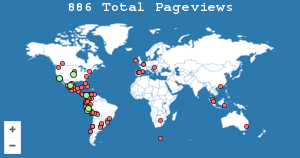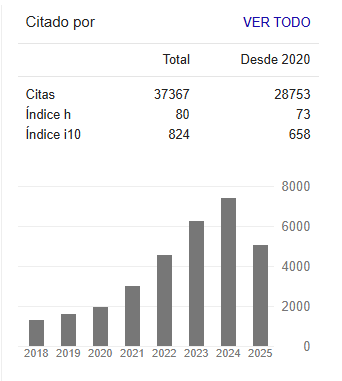Rol mediador de los influencers en el comportamiento hacia las marcas
Resumen
El objetivo de la investigación fue establecer el rol mediador de los influencers en el comportamiento de los jóvenes de la generación Z en la actitud hacia las marcas, mediante el uso de las redes sociales y la lealtad. La metodología utilizada para el estudio fue de una investigación no experimental, se aplicó un cuestionario para una muestra aleatoria de 220 estudiantes universitarios (n=10; α=0.906 ω=0.912), se utilizaron pruebas de validez y confiabilidad, análisis factorial exploratorio mediante el Modelamiento de Ecuaciones Estructurales de Cuadrados Mínimos Parciales PLS-SEM en un modelo de medida reflectivo; además de un análisis multigrupo para explorar la heterogeneidad observada en las redes sociales de Instagram y TikTok. Los resultados mostraron que existe un rol de mediador de los influencers en el comportamiento hacia las redes sociales en la muestra estudiada y el análisis multigrupo indica que existen diferencias significativas en los seguidores de Instagram y TikTok. Se concluye la vigencia de un marketing de influencers, esto como consecuencia de la fragmentación de los medios convencionales y digitales, buscando cada día nichos de mercado cada vez más específicos.
Citas
Anderson, K. C., Knight, D. K., Pookulangara, S., & Josiam, B. (2014). Influence of hedonic and utilitarian motivations on retailer loyalty and purchase intention: A facebook perspective [Article]. Journal of Retailing and Consumer Services, 21(5), 773-779. https://doi.org/10.1016/j.jretconser.2014.05.007
Arora, A., Bansal, S., Kandpal, C., Aswani, R., & Dwivedi, Y. (2019). Measuring social media influencer index- insights from facebook, Twitter and Instagram [Article]. Journal of Retailing and Consumer Services, 49, 86-101. https://doi.org/10.1016/j.jretconser.2019.03.012
Ashraf, R. U., Hou, F., & Ahmad, W. (2019). Understanding Continuance Intention to Use Social Media in China: The Roles of Personality Drivers, Hedonic Value, and Utilitarian Value [Article]. International Journal of Human-Computer Interaction, 35(13), 1216-1228. https://doi.org/10.1080/10447318.2018.1519145
Chen, H. (2018). College-aged young consumers’ perceptions of social media marketing: The story of Instagram. Journal of Current Issues & Research in Advertising, 39(1), 22-36.
DeMars, T. R. (2020). Big Data. In Communication Technology Update and Fundamentals (pp. 305-319). Routledge.
Fornell, C., & Larcker, D. F. (1981). Evaluating structural equation models with unobservable variables and measurement error. Journal of marketing research, 18(1), 39-50.
Gamage, T. C., & Ashill, N. J. (2022). # Sponsored-influencer marketing: effects of the commercial orientation of influencer-created content on followers’ willingness to search for information. Journal of Product & Brand Management, ahead-of-print(ahead-of-print). https://doi.org/10.1108/JPBM-10-2021-3681
Goanta, C., & Ranchordás, S. (2020). The regulation of social media influencers. Edward Elgar Publishing.
Gutierrez-Aguilar, O., Escobedo-Maita, P., Calliñaupa-Quispe, G., Vargas-Gonzales, J. C., & Torres-Huillca, A. (2022). The use of social networks, usefulness and ease of use, enjoyment through positive emotions and their influence on school satisfaction mediated by school achievement. Iberian Conference on Information Systems and Technologies, CISTI,
Gutierrez-Aguilar, O., Rodriguez-Rios, M., Patino-Abrego, E., & Cateriano-Chavez, T. (2021). Co-teaching and the use of WhatsApp as a mediation tool between parents with children with disabilities and their teachers. Proceedings - 2021 4th International Conference on Inclusive Technology and Education, CONTIE 2021,
Hodgson, A. (2018). Generation Z: The next wave of consumers. Euromonitor International.
Hopkins, J. (2019). Monetising the dividual self: The emergence of the lifestyle blog and influencers in Malaysia (Vol. 8). Berghahn Books.
Hu, L.-t., & Bentler, P. M. (1998). Fit indices in covariance structure modeling: Sensitivity to underparameterized model misspecification. Psychological Methods, 3, 424-453. https://doi.org/10.1037/1082-989X.3.4.424
Hülsing, G. (2021). # Triggerwarning: Body Image: A qualitative study on the influences of TikTok consumption on the Body Image of adolescents University of Twente].
Jin, S. V., Muqaddam, A., & Ryu, E. (2019). Instafamous and social media influencer marketing. Marketing Intelligence & Planning, 37(5), 567-579. https://doi.org/10.1108/MIP-09-2018-0375
Jin, S. V., & Ryu, E. (2020). “I’ll buy what she’s# wearing”: The roles of envy toward and parasocial interaction with influencers in Instagram celebrity-based brand endorsement and social commerce. Journal of Retailing and Consumer Services, 55, 102121.
Jun, S., & Yi, J. (2020). What makes followers loyal? The role of influencer interactivity in building influencer brand equity. Journal of Product & Brand Management, 29(6), 803-814. https://doi.org/10.1108/JPBM-02-2019-2280
Kim, M., & Baek, T. H. (2022). I’ll follow the fun: The extended investment model of social media influencers. Telematics and Informatics, 74, 101881. https://doi.org/https://doi.org/10.1016/j.tele.2022.101881
Kosiba, J. P. B., Odoom, R., Boateng, H., Twum, K. K., & Abdul-Hamid, I. K. (2022). Examining students’ satisfaction with online learning during the Covid-19 pandemic - an extended UTAUT2 approach. Journal of Further and Higher Education, 46(7), 988-1005. https://doi.org/10.1080/0309877X.2022.2030687
Latha, K., Meena, K. S., Pravitha, M. R., Dasgupta, M., & Chaturvedi, S. K. (2020). Effective use of social media platforms for promotion of mental health awareness [Article]. Journal of Education and Health Promotion, 9(1), Article 124. https://doi.org/10.4103/jehp.jehp_90_20
Leaver, T., Highfield, T., & Abidin, C. (2020). Instagram: Visual social media cultures. John Wiley & Sons.
Maes, C., & Vandenbosch, L. (2022). Adolescent girls’ Instagram and TikTok use: Examining relations with body image-related constructs over time using random intercept cross-lagged panel models. Body Image, 41, 453-459. https://doi.org/https://doi.org/10.1016/j.bodyim.2022.04.015
Mahy, P., Winarnita, M., & Herriman, N. (2022). Influencing the influencers: Regulating the morality of online conduct in Indonesia. Policy & Internet, 14(3), 574-596. https://doi.org/https://doi.org/10.1002/poi3.321
Martínez-García, J. A., & Martínez-Caro, L. (2009). La validez discriminante como criterio de evaluación de escalas: ¿teoría o estadística? Universitas Psychologica, 8, 27-36. http://www.scielo.org.co/scielo.php?script=sci_arttext&pid=S1657-92672009000100002&nrm=iso
Masuda, H., Han, S. H., & Lee, J. (2022). Impacts of influencer attributes on purchase intentions in social media influencer marketing: Mediating roles of characterizations [Article]. Technological Forecasting and Social Change, 174, Article 121246. https://doi.org/10.1016/j.techfore.2021.121246
Meng, K. S., & Leung, L. (2021). Factors influencing TikTok engagement behaviors in China: An examination of gratifications sought, narcissism, and the Big Five personality traits. Telecommunications Policy, 45(7), 102172. https://doi.org/https://doi.org/10.1016/j.telpol.2021.102172
Meske, C., Wilms, K., & Stieglitz, S. (2019). Enterprise Social Networks as Digital Infrastructures - Understanding the Utilitarian Value of Social Media at the Workplace [Article]. Information Systems Management, 36(4), 350-367. https://doi.org/10.1080/10580530.2019.1652448
Pier, D. (2022). Digital influencers and beer-branding folk dancers: the class stratification of participatory marketing in Uganda. Globalizations, 1-21. https://doi.org/10.1080/14747731.2022.2135424
PrakashYadav, G., & Rai, J. (2017). The Generation Z and their social media usage: A review and a research outline. Global journal of enterprise information system, 9(2), 110-116.
Pretorius, C., McCashin, D., & Coyle, D. (2022). Mental health professionals as influencers on TikTok and Instagram: What role do they play in mental health literacy and help-seeking? Internet Interventions, 30, 100591. https://doi.org/https://doi.org/10.1016/j.invent.2022.100591
Reinikainen, H., Kari, J. T., & Luoma-Aho, V. (2020). Generation z and organizational listening on social media [Article]. Media and Communication, 8(2), 185-196. https://doi.org/10.17645/mac.v8i2.2772
Thelwall, M., & Cash, S. (2021). Bullying discussions in UK female influencers’ YouTube comments. British Journal of Guidance & Counselling, 49(3), 480-493. https://doi.org/10.1080/03069885.2021.1901263
Wang, F., She, J., Ohyama, Y., Jiang, W., Min, G., Wang, G., & Wu, M. (2021). Maximizing positive influence in competitive social networks: A trust-based solution. Information Sciences, 546, 559-572. https://doi.org/https://doi.org/10.1016/j.ins.2020.09.002
Weigel, R. H. (1983). Environmental attitudes and the prediction of behavior. Environmental psychology: Directions and perspectives, 257-287.
Wolf, A. (2020). Gen Z & Social Media Influencers: The Generation Wanting a Real Experience.
Zhu, Y.-Q., Amelina, D., & Yen, D. C. (2022). Celebrity endorsement and impulsive buying intentions in social commerce-The case of instagram in Indonesia: Celebrity endorsement. In Research Anthology on Social Media Advertising and Building Consumer Relationships (pp. 1401-1419). IGI Global.

Esta obra está bajo licencia internacional Creative Commons Reconocimiento-NoComercial-CompartirIgual 4.0.








.png)






























